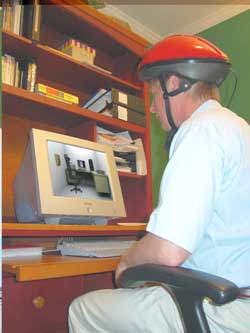Mind Over Matter
Inattention causes accidents and injuries. This system trains the brain to stay attuned.
 IT'S
IT'S not exactly rocket science, but close enough. Launched recently by
Unique Logic and Technology Inc. (ULT) of Asheville, N.C., a computer-based
training program named Play Attention Adult® (PA
2) focuses on one of the all-important yet least-delved
aspects of occupational safety and health: paying attention. The program is
based on the premise that attention control is a thoroughly learnable skill, and
its space-age method is all in the mind.
The PA2 system employs patented technology
that is a modification of techniques NASA developed for monitoring pilots'
attention in flight simulators to reduce accident rates, and it is similarly
designed to combat the challenges and potential dangers associated with
inattention in the workplace. As serious as its consequences are, the "Play" in
its name is derived from the software's series of video game-like exercises that
users complete during training. No joysticks or other game controllers are
needed for these games, though, because users accomplish movement and
manipulation of the on-screen objects through brain power alone.
Beta Business Bureau
The system uses a sensor-lined helmet attached
to an interface unit that plugs into any Windows-based PC or Mac. The
low-stimuli games rely on the helmet's sensors to monitor the user's brain
waves, which the interface box then interprets and augments for visible,
real-time results in the on-screen action. When users are tuned in and focusing,
they emit the necessary beta waves required to complete the various tasks and
otherwise "win" the game. Daydreaming or distraction results in high theta
waves, which cause regression from the games' goals. The better a user
concentrates and controls attention, the more successful the results.
Scenarios can be customized to mimic any work site's control panels or office
settings. In one exercise designed for use in a bank, for example, the goal is
to move a fax machine printout to an in-box on the other side of the screen, a
feat accomplished only by concentrating on the animated page. When users fidget
or lose focus, the printout drifts back toward the fax machine. The feedback
provided is instant as users see and hear how they're progressing, which
PA2 inventor and ULT CEO Peter Freer says results
in encouraging the practice of skills that retrain the brain in how to think
more clearly and attentively. Other exercises focus on improving the cognitive
skills needed to finish tasks, increase memory, and filter out distractions.
The entire program consists of 40 to 60 hours of training conducted in
twice-weekly sessions of 30 to 40 minutes each, after which participants'
attention is permanently improved, Freer said. He added that while that duration
obviously does not qualify the program as a "quick fix," the results are worth
the commitment.
"Behavioral patterns and development of cognitive skills takes time," he
said. "Attention control is a learnable skill, and it's a skill we teach. It's
vitally important to realize that that's where we fit in. We are skill
builders."
Attention Squared
Freer, a former elementary school teacher with
special training through the National Science Foundation in educational computer
programming and software, introduced the original, school-based Play Attention
Learning System in 1994. It is used in 450 school systems and 20 learning
centers throughout the country with many more abroad.
While adults can and do build attention skills using that program, its
structure is child- and adolescent-oriented. The new PA2 caters specifically to adult and workplace populations.
These receive considerably less attention in matters of ADD or ADHD, despite the
fact that the condition persists into adulthood for an estimated 60 percent of
children diagnosed with it, according to Freer.
A recent study by the Harvard School of Public Health indicated ADHD affects
4 percent of the U.S. adult population, or 8 million adults, 80 percent of whom
don't know they have it, much less receive treatment for it. Many researchers
say those numbers are conservative, but percentages are difficult to determine
because most adults with ADHD do not reveal their condition, fearing possible
scrutiny at work or, at worst, being fired.
The Americans with Disabilities Act covers individuals diagnosed with ADHD.
While most who have it prefer to keep it a don't-ask-don't-tell situation, this
could be difficult for them if their workplace implements PA2 as a mandatory program, even with the best intentions.
"There are companies, though, that actually understand these individuals and,
knowing their limitations, want to encourage them rather than fire them and try
to retrain someone else," Freer said.
ULT sells two versions of the system: an industrial package for $2,500 that
allows unlimited users and a personal package for $1,795, which limits use to
two people who are automatically enrolled in the equivalent of a
distance-learning program. Instructing an on-site supervisor to implement the
program is part of the industrial package, but both versions include
professional, one-on-one support from PA2
trainers. For more information, visit www.playattention.com.
This column appears in the June 2005 issue of Occupational Health &
Safety.
This article originally appeared in the June 2005 issue of Occupational Health & Safety.